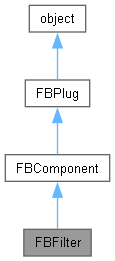Filters are used to modify motion capture data. More...
#include <pyfbsdk_generated.h>

Public Member Functions | |
| FBFilter () | |
| Constructor. | |
| bool | Apply (FBFCurve pCurve) |
| Apply the filter to an FCurve. | |
| bool | Apply (FBAnimationNode pNode, bool pRecursive) |
| Apply the filter to an animation node. | |
| Reset () | |
| Reset properties. | |
 Public Member Functions inherited from FBComponent Public Member Functions inherited from FBComponent | |
| FBComponent () | |
| Constructor. | |
| str | ClassName () |
| Get the class name. | |
| DisableObjectFlags (FBObjectFlag pFlags) | |
| Disable a specific Object Flags. | |
| EnableObjectFlags (FBObjectFlag pFlags) | |
| Enable a specific Object Flags. | |
| bool | FBCreate () |
| Open Reality Creation function. | |
| FBDelete () | |
| Open Reality deletion function. | |
| FBDestroy () | |
| Open Reality destruction function. | |
| FBObjectFlag | GetObjectFlags () |
| Get all Object Flags (concatenated). | |
| bool | GetObjectStatus (FBObjectStatus pStatus) |
| Check to see if an object status is enabled. | |
| FBFileReference | GetOwnerFileReference (p0) |
| Get the owner FileReference object. | |
| HardSelect () | |
| HardSelect. | |
| bool | HasObjectFlags (FBObjectFlag pFlags) |
| Check whether a specific object flag is enabled. | |
| bool | Is (int pTypeId) |
| Returns true if object is of type TypeId. | |
| bool | ProcessNamespaceHierarchy (FBNamespaceAction pNamespaceAction, str pNamespaceName, str pReplaceTo=None, bool pAddRight=True) |
| ProcessNamespaceHierarchy. | |
| bool | ProcessObjectNamespace (FBNamespaceAction pNamespaceAction, str pNamespaceName, str pReplaceTo=None, bool pAddRight=True) |
| ProcessObjectNamespace. | |
| int | PropertyAdd (FBProperty pProperty) |
| Add a property to the component's property manager. | |
| bool | PropertyAddReferenceProperty (FBProperty pReferenceProperty) |
| Add a reference property to the component's property manager. | |
| FBProperty | PropertyCreate (str pName, FBType pType, str pDataType, bool pAnimatable, bool pIsUser=False, FBProperty pReferenceSource=None) |
| Create user or dynamic property. | |
| PropertyGetModifiedList (FBArrayTemplate< FB > pPropList, FBPlugModificationFlag pModificationFlags) | |
| Get list of properties which have been modified since last loading. | |
| PropertyRemove (FBProperty pProperty) | |
| Remove a Property from the component's Property manager. | |
| SetObjectFlags (FBObjectFlag pFlags) | |
| SetObjectFlags. | |
| SetObjectStatus (FBObjectStatus pStatus, bool pValue) | |
| Enable/Disable a specific Object Status. | |
Public Attributes | |
| FBTime | Start |
| Read Write Property: Start time of the filtering region | |
| FBTime | Stop |
| Read Write Property: Stop time of the filtering region | |
 Public Attributes inherited from FBComponent Public Attributes inherited from FBComponent | |
| FBListComponent | Components |
| List: List of components. | |
| str | LongName |
| Read Write Property: Name and namespace for object. | |
| str | Name |
| Read Write Property: Unique name of object. See sample: RemoveSuffixFromNameOfSceneElements.py. | |
| FBListComponent | Parents |
| List: Parents. | |
| FBManager | PropertyList |
| Read Only Property: Manages all of the properties for the component. | |
| bool | Selected |
| Read Write Property: Selected property. | |
| int | TypeInfo |
| Contains the Type information of the object. | |
 Public Attributes inherited from FBPlug Public Attributes inherited from FBPlug | |
| str | ClassGroupName |
| ClassGroupName of the object. | |
| int | TypeInfo |
| TypeInfo. | |
Filters are used to modify motion capture data.
Filters are objects which can be applied on a FCurve, or the animation node associated with an animated object property, to modify shape and number of keys. Filters can be created from the GUI, using the Filters tool, or programmatically with an instance of a FBFilterManager.The filter properties can be found in the object's PropertyList data member. They will use the same name, and be of the same type, as what can be seen in the GUI.Instances of FBFilter should be created with the help of the class FBFilterManager. Only internal application code should call the FBFilter's class constructor.Sample C++ code:
Sample Python code:
| FBFilter | ( | ) |
Constructor.
| bool Apply | ( | FBAnimationNode | pNode, |
| bool | pRecursive | ||
| ) |
Apply the filter to an animation node.
This is the other apply method and it can be used on an object's animation node.
| pNode | Node to apply filter to. |
| pRecursive | Recursively apply filter on child nodes? |
Apply the filter to an FCurve.
This is one of the two apply method that is meant to be called by client code. The FCurve can be a standalone independant FCurve, or can be associated to an object's animated property.
| pCurve | FCurve to apply filter to. |
| Reset | ( | ) |
Reset properties.
| FBTime Start |
Read Write Property: Start time of the filtering region
| FBTime Stop |
Read Write Property: Stop time of the filtering region